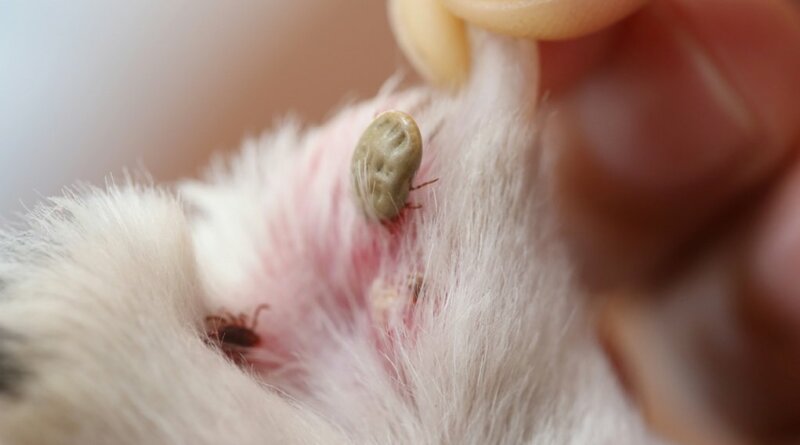Signs, Treatments and 10 Ways to Prevent It
[ad_1]
Unlike humans, Lyme disease in dogs is a less common scenario after being bitten by an infected by a tick. Instead, dogs will often develop fever, lameness, anorexia, depression and, in more rare cases, nephropathy. It was previously thought that only the deer tick carried the disease, but it is now known that many species carry Lyme disease.
In North America and Europe, Lyme disease is the most prevalent parasite-born illness that affects dogs and humans alike. Typically, the disease is caused by a spirochete Borrelia burgdorferi sensu stricto which is the black-legged tick Ixodes scapularis that’s common in the US and Canada.
Recognize the enemy – this is what a black-legged tick looks like:
Symptoms of Dog Lyme Disease
Even though Lyme disease in dogs can be easily transmitted by ticks, it causes clinical signs in only 5% of dogs who are affected with the disease.
The most common symptoms in dogs with Lyme disease have been recorded in a 2015 study: lameness, joint swelling and arthritis, depression and a listless appetite, vomiting, diarrhea, weight loss, increased urination and abnormal fluid buildups.
There are other signs and symptoms that veterinarians associate with canine Lyme disease that you could watch for at home:
- An arched back with a stiff walk
- Touch sensitivity
- Breathing difficulties
- Swollen lymph nodes
How to Diagnose Lyme Disease in Dogs
Diagnosis of Lyme disease can be done by your veterinarian taking a complete history of the dog and by running some basic blood work. History would indicate physical symptoms and possibly exposure to a tick bite, if it were in fact noticed.
However, simple diagnosis isn’t as easy as it sounds and veterinarians are aware that the results aren’t always accurate. The two most popular types of tests for Lyme disease are:
- One is a type of antibody blood test using C6 enzyme-linked immunosorbent assay (ELISA) which detects presence of a dog’s antibodies that have formed in reaction to the Lyme disease. If the test is positive, then it means a dog has Lyme disease.
- The second test, called a PCR (polymerase chain reaction) test, looks for specific DNA in the dog.
There are other tests that may be performed if needed, such as complete blood cell count test, biochemistry test, synovial fluid cytology and culture testing.
The problem with all of these Lyme disease tests is that false negative results can occur in dogs who are suffering from Lyme. Veterinarians know this and often use medical history and other resources for a 5-factor table to draw a more accurate conclusion.
How to Treat Lyme Disease in Dogs
Do not attempt to treat a dog for Lyme disease only if you suspect it to be the case. A veterinarian must confirm that the dog is actually infected and then develop a treatment plan. As noted above, even after the first test, the situation may still be unclear.
The treatment will usually include antibiotics for at least one month, given to dogs at a dosage of 10 mg per 2 lbs of a dog’s body weight. This will generally resolve most symptoms, but they can still recur. Dogs with Lyme nephropathy will usually need a longer treatment course.
Doxycycline is the most commonly prescribed antibiotic for dogs with Lyme disease, but many other antibiotics can also be effective. Your vet may also prescribe a pain reliever if your dog seems to be experiencing any pain or stiffness. For example, amoxicillin is the go-to antibiotic for puppies, given for 30 days at 20 mg per 2 lbs of body weight.
A dog with Lyme disease will respond to antibiotic treatment in the first few days.
10 Ways to Prevent Lyme Disease in Dogs
Some of the best ways to prevent ticks and Lyme disease for your dogs are:
- Avoiding higher risk areas during warmer seasons
- Checking the dog for ticks every day, but especially after walks in high risk areas
- Manage your landscape: remove leafs, dirt, vegetative covers and similar
- Prevent wildlife from entering your yard by using barriers and fences
- Use acaricides that contain permethrin like SaverPak or Control Solutions; they are very effective at killing ticks and are safe for dogs (but toxic to cats!)
- Consider routinely vaccinating your dog against the disease but keep in mind that scientists are currently debating whether vaccines are worth it to prevent Lyme in dogs due to potentially increasing the risk of Lyme nephropathy in dogs, especially for breeds that are more at risk.
Below are some more tips in detail on how to prevent Lyme disease in dogs and prevent exposure to ticks on a daily basis.
1. Treat Year Round
Tick season is not actually a “season”. Year-round diligence is important to prevent Lyme disease in dogs. Many pet owners skip treating their dogs in the winter months thinking that it saves them the expense.
However, many ticks don’t die out in the winter and while the exposure risk is reduced due to cold weather, it’s still possible for the dog to get infected. Blacklegged ticks in particular, which are the prime carriers of Lyme disease, will survive in winter as long as it’s not freezing.
2. Lyme Disease is Always Near By
Lyme is everywhere but some areas are more dangerous than others. It is true that Lyme disease used to be located in certain parts of the country but it has spread. CDC warns that it is now located in every U.S. state and there is no place that is completely safe from Lyme disease so it’s best to assume that you are in a “Lyme disease area”.
3. Understand Your Flea and Tick Repellents
Most people do not understand that their monthly flea and tick repellent, whether it be orally taken or dropped on the dog’s back, does nothing to repel ticks. It will kill the tick after it has bitten your dog, and only reduces the chance your dog will get Lyme disease.
The best way to prevent Lyme disease and tick bites on dogs is to have your dog vaccinated as well as use a monthly flea and tick repellent. The vaccine will protect your dog against the disease itself, but it requires a yearly booster.
4. Waiting for Symptoms Is Not a Good Idea
While there is value to watching for symptoms of dog Lyme disease, if you start to see them in your pooch, it is a little too late. Your dog will already be suffering the effects of the illness and will require a longer (and more expensive) treatment.
Humans often get a bulls-eye rash indicating the infection and can get treatment right away – this wards off the devastating illness. However, you will not see a rash on your fur-covered dog and by the time you see the symptoms, the disease will be in full course.
As noted above, symptoms that are common to Lyme disease are joint pain, limping, fever, depression and loss of appetite. If you notice any of these signs or suspect your dog may have been exposed to Lyme disease, call your vet right away.
5. Find Ticks Where They Hide
Ticks are often found in wooded areas, high grass, and tall bushes. When you are looking on your dog for ticks, it can be difficult because ticks like to hide and they’re good at it. Ticks also like blood. This is why you can usually find ticks on more vascular areas of a dog’s body where you can see the blood vessels close to the surface.
Ticks can also be found on a dog’s exposed skin, their ears, and between the toes. Try looking behind your pet’s neck because ticks like to hide where your dog can’t reach them easily.
6. Remove the Tick Safely
The best way to remove a tick is with a pair of tweezers or a tick remover. Wear gloves and using sterile tweezers grab the tick near the head and pull straight back and remove. This may take patience and help from a friend to keep the dog calm and steady. There can be one or many ticks, and it can take time to ensure they are all removed.
Be sure to kill all all ticks after removing them. If you have a cut on your finger or hand, and you squish the tick and get blood on your open wound, there is a risk of transmission of Lyme disease to you. It’s best to wear gloves while removing the tick, and submerse it in rubbing alcohol to kill it instead of squishing it with your fingers.
7. Discuss Treatment Options
Just as there is a problem with an overuse of antibiotics in humans, there is also the same issue in pets. Overuse of antibiotics in general has led to more difficult strains of antibiotic resistant diseases, including ticks infected with Lyme.
Veterinarians are known to not use any antibiotics for Lyme disease in dogs if there are no clinical symptoms but only a positive blood test. Your vet will discuss these options with you. If your dog is showing symptoms, the usual course of doxycycline or other antibiotic is prescribed for about 4 weeks. If symptoms return, an additional course may be needed.
8. Keep the Dog’s Breed in Mind
Some breeds are affected more than others by Lyme disease. These breeds or mixes of these breeds should be treated immediately if they test positive for Lyme or are suspected of having Lyme disease.
Lyme can cause serious complications and destroy the dog’s kidneys. Kidney disease and related renal complications are often found in Labrador Retrievers, Golden Retrievers, Shetland Sheepdogs and Burmese Mountain dogs.
These dog breeds should be seen by the vet for a treatment immediately. Doxycycline or another antibiotic should be started as soon as possible.
9. Get Treatment Fast
It’s often hard to realize that your dog has Lyme disease and by then they may have had it for some time. So when the time comes, do not delay the treatment any further. Once you suspect Lyme disease to be the case or see any clinical signs, contact your vet.
Lyme is still a type of bacterium, so it can be controlled by antibiotics. But even with early treatment, it often takes at least one month to help a diseased dog beat the illness. If your pet has had Lyme for a long time, it may take more than one treatment and longer than a month. Your veterinarian may suggest a stronger antibiotic if necessary.
10. Protect Your Property
Learn how to create a tick-safe zone around your property to prevent ticks in the yard and elsewhere in the house. You can reduce tick habitats in your backyard by keeping it mowed and raked.
You should clear away all the tall grasses and brush from your backyard. You can also have a professional company spray your yard for fleas and ticks. There are many products on the market that you can find to do it yourself, such as Wondercide (liquid spray), Ortho (granules), and Thermacell (treat tubes).
All tick treatments for backyard are manufactured to be safe for pets and kids, so they will be non-toxic to your dog. The different types such as sprays, granules, treats makes it easier to choose whatever is more convenient and easier for you to use in your home.
READ NEXT: The Ultimate Dog Fleas and Ticks Survival Guide
Want to share this?
[ad_2]
Source link









Get here. Some trends of drugs.
canadian medications
safe and effective drugs are available. Long-Term Effects.
Some trends of drugs. Get information now.
https://canadianfast.com/
Top 100 Searched Drugs. Medscape Drugs & Diseases.
Very good blog! Do you have any helpful hints for aspiring writers?
I’m hoping to start my own blog soon but I’m a little lost
on everything. Would you advise starting with a free platform like WordPress or go for a paid option?
There are so many options out there that I’m totally overwhelmed ..
Any recommendations? Thanks a lot!
order cytotec online https://cytotec.ink/# – buy cytotec pills online cheap
pharmacies in canada that ship to the us recommended canadian pharmacies canadian pharmacy online ship to usa canadiandrugs.tech
dark web sites deep web markets darknet markets url
Misoprostol 200 mg buy online https://cytotec24.com/ buy cytotec online fast delivery